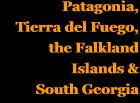 |
|||||||||||||
 |
|||||||||||||
 |
|||||||||||||
 |
|||||||||||||
Main pages
Appendices
Chapter 3
The BAGSR's route to Neuquén


Chapter 3 Appendix 17
Southern Transandine Railway
In relation to this transandine way, an agreement was signed in Santiago de Chile on 25/4/1922 by which it was established that the Governments of Chile and the Argentine reciprocally resolved on the construction of two lines of railway which would join the two countries without transshipment. First in the North, Salta to Antofagasta, opened on 25 May 1948 and the other in the South, which would link the Argentine port of Bahía Blanca with the Chilean one of Talcahuano on the Pacific. Leaving from the railhead at Zapala, there are two alternatives for the route
a) Paso del Arco|
b) by Mallín Chileno.
In 1956, all questions relating to the Southern Transandine Railway were definitely interrupted.
It should be emphasised that for the route of the railhead at Zapala to the Chilean frontier (by Mallín Chileno), only 135 kilometres, remains to be built. To complete the route to the frontier at Paso del Arco some 172 kilometres of railway remains to be built.
The carrying-out of the section Zapala to the frontier would complement the development foreseen in La Región. As a work of development, its sphere of influence will be concentrated on the area of Lago Aluminé, of great potential richness in forest and farming products and electric energy. Also must be mentioned the thermal springs of Copahue, in the zone of Las Lajas and the region of Comahue.
The potential traffic of this railway will consist in livestock on foot, frozen meats and meat products, cereals, forage, manufactured and food products and on the Chilean side, wood, iron, steel, coal, cement, etc.
The benefits which the thousands of fertile hectares suitable for agriculture must be mentioned as well as the advantages for general sea traffic which the union of the ports of the Atlantic and Pacific oceans offer.
In the month of September 1985, the National Parliament sanctioned Law N ş 23.253 which stipulated in its first clause:
The tasks of construction of the stretch of railway to lengthen the line of the Ferrocarril Nacional General Julio A. Roca shall be carried out from the rail head in Zapala to the frontier with the Republic of Chile crossing the Cordillera of the Andes by Paso Lonquimay or Pino Hachado traversing the route which according to previous surveys gives the greater convenience.”
27-1-2018